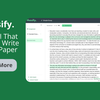{shortcode-e8175e6da9eada116f9a698ca9821345a297cc88}
From now until Jan. 12, should you find yourself wandering aimlessly around Harvard Yard, consider exploring Houghton Library’s latest exhibition, “Edward Gorey: The Gloomy Gallery.” Against the gorgeous backdrop of the Edison and Newman Room, the whimsical, slightly sinister, and always bizarre illustrations of Edward S. J. Gorey ’50 take on a new, distinctly Harvard quality.
Visitors might be familiar with Gorey’s most famous work, “The Gashlycrumb Tinies,” a small book of illustrations and limericks about children dying in strange ways with an example for each letter of the alphabet. Upon entering the exhibition, however, visitors dazzled with an array of other paper creations. Take, for instance, “The Tunnel Calamity,” an enchanting layered-book-turned-archway featuring strange characters lounging in doorways, or “The Helpless Doorknob,” a card deck of character illustrations and simple sentences that can be shuffled to create a seemingly endless number of nonsensical stories.
Each work featured in this collection displays Gorey’s brilliant, detail-obsessed mind, unafraid to venture into the darkest subject matter, but never without a flicker of humor to brighten the way. Gorey’s line drawings are mostly black and white and feature awkward, long-limbed, big-eyed characters who always appear to be darting around, hiding behind corners, or engaging in some strange, inexplicable behavior. One can’t help but imagine Gorey himself as one of his solemn, out-of-place characters, quietly engaging in mischief.
“The Gloomy Gallery” is organized mostly by subject matter and form, with categories as idiosyncratic as Gorey himself. “The Curious Sofa” illustrates Gorey’s “penchant for leaning, fainting, flopping, and other mainly anemic means of collapse,” depicts just that — drawings of vaguely Victorian characters mid-faint. “Tinned Lettuce,” in another display case, showcases Gorey’s “peculiar attention to words, letters, and language.” These idiosyncratic strategies of collection and display highlight Gorey’s unique approach to creativity; the absurd phrases and spindly, blank-faced characters in surreal settings come alive within the highly specific, hard-to-place categories, for they highlight details that viewers may otherwise have missed.
Of particular interest to the Harvard viewer is “Tony & Ted,” a section dedicated to Gorey’s time at Harvard beginning in 1946. Gorey graced several Harvard institutions including The Harvard Advocate and the Signet Society, illustrating for both. Still, rather than solely featuring Gorey’s institutional contributions to Harvard life, this portion of the exhibit also explores Gorey’s friendship with his Eliot House roommate, Anthony “Tony” N. Smith ’37, through scraps of illustrated memorabilia. A snarky birthday card, a surprisingly touching gilt illustration of “St. Torpid” on a candy wrapper, and “A Pious Poem Penned to Prevent a Painful Perturbation” reveal another side of Gorey — a possibly lovesick, possibly closeted artist expressing his darkly funny desires through his talent.
These scraps of paper ephemera give viewers an intimate glimpse into Gorey’s time at Harvard as a young artist discovering, like so many young artists at the school, the institutions and people who appreciate and uplift their passion and creativity. The objects paint a picture of a creative finding a home among others like him, adding a tinge of sweetness and comfort to the rest of the exhibit.
Walking through the gallery and exploring the multitude of inventive creations, the viewer is welcomed into Gorey’s world. Cutouts of his characters peer out at visitors from Houghton’s bookshelves, appearing right at home. The luxurious atmosphere of the Edison and Newman Room enhances the experience of Gorey’s work, inviting viewers to linger and examine every detail.
Consider “The Worsted Monster,” a play captured in the form of a paper theater complete with intricate set and costume design. In muted colors and fine lines, a quiet yet intricate world unfolds before the viewer. Small winged creatures hold up the curtains of the set to reveal a forest of dark, spindly trees. A woman clasps her hands together, her dress floating around her as if suspended in water. A mustachioed man poses before a Greek statuette. Though small and initially unassuming, this work betrays incredible depth and attention for viewers who take the time to sit with the details.
This is the true charm of “Edward Gorey: The Gloomy Gallery.” Although it may first appear somewhat quaint as a single room of glass cases in a quiet Harvard library, this whimsical display of Gorey’s world strives to entice even the most skeptical of viewers. His creations are unlike anything else, with their witty turns of phrase and surreal scenes of domestic oddity. As autumn descends upon Harvard and the days shorten, take a moment to explore the darker side with Edward Gorey.
“Edward Gorey: The Gloomy Gallery” provides viewers with an intimate window into Gorey’s work, from poems and plays to decks of cards and miniature theaters.
“Edward Gorey: The Gloomy Gallery” is on view at the Houghton Library through Jan. 12, 2026.













